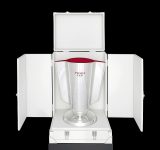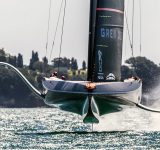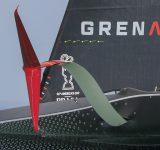Featured on the first INEOS Team UK AC75, Britannia, are flaps and fences on the foils allowed by the new design rule.
Flaps are not allowed on the T-foil of the rudder, but are allowed on the T-foils of the two foil arms.
The foils on Britannia clearly show adjustable flaps on the trailing edges, and a series of short, low fences spaced across the lower surface of the foils, possibly involved with the foil operation mechanism.
This is similar to an aircraft wing design feature to maintain front to back flow accross the foil and reduce stalling of the foils, possibly leading to an uncontrollable nose-up pitch action as speed drops.

On the INEOS Team UK hull, the foil arm rotation points appear to be set neatly within the turn of the bilge in the slab sided hull, rather than on exposed structure as the other team designs.
The actual width of the hull is restrained by the measurement of the pivot points of the two foil arms, so it would appear that the Ineos arms are at maximum, with apertures in the vertical slab sides to allow full rotation.
The other teams have built the rotation bearings in pods or dimples to allow the armw ro rotate fully without hitting the hull, they have also added slight flair to the sides.
In an interview with Yachting World, skipper Ben Ainslie commented that without a keel, hull stability was reliant on the lift from the foil arm and wings, and controlling the speed to create righting moment, was crucial to achieve take-off.

For this information their work with the test boat and simulator has been critical to developing techniques, both for the designers and for the crew.
To help achieve this lift-off the ETNZ boat has incorporated a pronounced bustle from the mid-point aft, and Luna Rossa has an obvious keel line skeg running the length of the hull, but both the British and the American’s have gone for clean, scow type hulls.
Anslie added, we think – we hope – we’ve got a good idea of how this is going to play out and what sort of speed we need to create righting moment, and ultimately to take-off.
Related Post:








 RSS – Posts
RSS – Posts